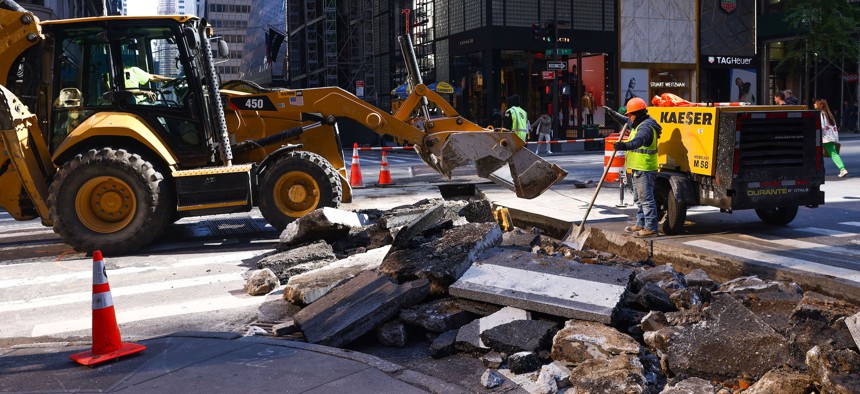Inflation Is Cutting Into States’ Big Infrastructure Windfall

Road work on 5th Avenue in Midtown Manhattan, New York, United States, on October 22, 2022. NurPhoto via Getty Images
The costs of road and bridge projects have increased by as much as 40%.
This story was originally published by Stateline, an initiative of The Pew Charitable Trusts.
When Ohio transportation officials got the bids back in spring for the next phase of an expansion of Interstate 75 north of Cincinnati, they had a rude awakening.
Inflation had driven up the mega-project’s cost by about $100 million above the $171 million state engineers had estimated. Officials decided to redesign the project, break it up into smaller phases and rebid it, putting off construction until the fall of 2023.
Ohio transportation officials are getting nearly $2 billion over five years from the $1.2 trillion federal bipartisan infrastructure law. But so far, the money they’ve received “has largely been gobbled up by inflation,” said Matt Bruning, spokesperson for the Ohio Department of Transportation. “It didn’t take all of it, but we’re pretty close to a net sum zero because of it.”
Across the country, many transportation agencies, which are getting about $350 billion in additional money for road and bridge projects over five years from the 2021 infrastructure law, tell a similar story.
States have been seeing 20% to 40% hikes in project costs, depending on the region and materials, said Susan Howard, director of policy and government relations at the American Association of State Highway and Transportation Officials.
“You have to settle for less or use this money for projects on track that you already planned to do, instead of the dream projects you haven’t realized,” Howard said.
The cost of asphalt, for example, was up more than 20% in October 2022, compared with October 2021, according to the Associated General Contractors of America, a construction industry trade group.
Concrete costs rose 14%, and fabricated structural metal for bridges jumped more than 23% during that period.
“Road construction is almost a perfect storm for inflation,” said David Ditch, a transportation policy analyst at The Heritage Foundation, a conservative Washington, D.C.-based think tank.
Ditch said construction is energy intensive and strongly affected when fuel prices shoot up dramatically, as they did during the first half of 2022. Builders need fuel to transport and run heavy equipment, and asphalt is petroleum-based.
Ditch said at this point, inflation is not enough to completely consume all the federal infrastructure law spending. “But we have no idea what will happen with it in the next several years,” he said.
Transportation officials say supply chain disruptions also are extending the time it takes to get and deliver materials and equipment. And the high demand for skilled road construction workers means they can command higher wages, according to Ditch.
In Maine, state transportation officials rejected bids for seven road or bridge work projects this year because the costs came in well over what officials had estimated. They had planned to spend $28 million on the projects; the low bids came in at $50 million.
One bid for a bridge replacement outside of Bangor was nearly double what the agency had budgeted, according to Maine Department of Transportation spokesperson Paul Merrill.
“The seven projects we couldn’t justify awarding this year will have to be delayed at least a year,” he said, noting that some will be broken up into smaller contracts.
Merrill said his agency first started dealing with a “supercharged bidding environment” for construction projects starting in 2019. COVID-19, supply chain issues and now inflation all have played a major role.
“When you have such a sticker shock with all these issues, including inflation, we have to be prudent stewards of the money we’re spending,” he said. “I don’t know anyone planning to spend $20,000 on a kitchen renovation who would not think twice about signing off if the lowest price from a contractor is $40,000.”
Alison Black, a senior vice president and chief economist for the American Road & Transportation Builders Association, said despite the extra costs, states are moving ahead with construction plans. During the 2022 fiscal year, her group says, about $53.5 billion of federal infrastructure money was committed to more than 29,000 projects.
Black noted that if a state awards a highway project this year, when inflation is high, it still can take several years to get it constructed. “As inflation hopefully eases in the future, that’s going to help,” she said.
But even if inflation eases dramatically, some experts say damage already has been done and may continue.
“It’s still eating away slowly but surely,” said Jeff Davis, a senior fellow at the Eno Center for Transportation, a Washington, D.C.-based nonprofit that analyzes policy. “Even if there are lower numbers, it could eat up the entire spending increase from the [infrastructure law].”
Howard, of the state transportation officials’ group, emphasized that the extra federal money still makes a big difference. “If we didn’t have these additional resources, states would be in a much bigger world of hurt,” she said.
Ohio transportation official Bruning said his agency is thankful it’s getting extra funding from the infrastructure law. It also has gotten a boost from a 10.5 cents-a-gallon state fuel tax increase that took effect in July 2019.
But inflation has added an element of uncertainty to the funding picture over the next several years.
“It may get worse. It may get better,” he said.





